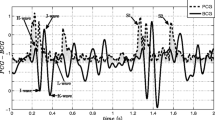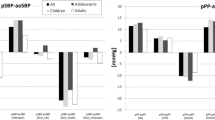Abstract
Introduction
Measurement of central (aortic) systolic blood pressure has been shown to provide reliable information to evaluate target organ damage. However, non-invasive central blood pressure measurement procedures are still under analysis.
Aim
To compare human pressure waveforms invasively obtained in the aorta, with the corresponding waveforms non-invasively recorded using an oscillometric device (Mobil-O-Graph).
Methods
In this research were included 20 subjects in which invasive percutaneous coronary interventions were performed. They were 10 males (68 ± 12 y. o., BMI: 27.4 ± 4.6 kg/m2) and 10 females (77 ± 8 y. o., BMI: 28.5 ± 5.3 kg/m2). During the invasive aortic pressure recording, a synchronized non-invasive Mobil-O-Graph acquisition beat by beat and reconstructed central pressure wave was performed. Both, invasive and non-invasive pressure waves were digitized and stored for subsequent analysis and calculations. A computerized interpolation procedure was developed in our laboratory to compare these pressure waves.
Results
A significant correlation between Mobil-O-Graph central blood pressure measurements and the corresponding invasive values was found in males (r < 0.81; p < 0.01) and females (r < 0.93; p < 0.01). However, in both genders, the slope of the regression lines was lesser than 1 (males: y = 0.7354x + 18.998; females: y = 0.9835x + 2.8432). In the whole population (n = 20), a significant correlation between Mobil-O-Graph central blood pressure measurements and the corresponding invasive values was found (r < 0.89; p < 0.01) and the regression line was lesser than 1 (y = 0.9774x + 1.7603).
Conclusions
In this research, a high correlation between invasive central blood pressure values and those measured with the Mobil-O-Graph device was found in males, females and the whole population. However, a sub estimation of Mobil-O-Graph central blood pressure values was observed.







Similar content being viewed by others
References
Stergiou GS, Parati G, Vlachopoulos A, et al. Methodology and technology for peripheral and central blood pressure and blood pressure variability measurement: current status and future directions—position statement of the European Society of Hypertension Working Group on blood pressure monitoring and cardiovascular variability. J Hypertens. 2016;34(9):1665–77.
Zanchetti A. Blood pressure measurement, blood vessels and treatment of hypertension. J Hypertens. 2018;36(3):449–50.
Kelly RP, Gibbs HH, O’rourke MF, Daley JE, Mang K, Morgan JJ, Avolio AP. Nitroglycerin has more favourable effects on left ventricular afterload than apparent from measurement of pressure in a peripheral artery. Eur Heart J. 1990;11:138–44.
Protogerou AD, Papaioannou TG, Lekakis JP, Blacher J, Safar ME. The effect of antihypertensive drugs on central blood pressure beyond peripheral blood pressure. Part I: (patho)-physiology, rationale and perspective on pulse pressure amplification. Curr Pharm Des. 2009;15:267–71.
Papaioannou TG, Protogerou A, Stefanadis C. Comparison between Mobil-O-Graph and the SphygmoCor device for central systolic blood pressure estimation: consensus is required for ‘validation protocols’. Blood Press Monit. 2012;17:259–60.
Takazawa K, Kobayashi H, Shindo N, Tanaka N, Yamashina A. Relationship between radial and central arterial pulse wave and evaluation of central aortic pressure using the radial arterial pulse wave. Hypertens Res. 2007;30:219–28.
Westerhof BE, Guelen I, Stok WJ, Lasance HA, Ascoop CA, Wesseling KH, Westerhof N, Bos WJ, Stergiopulos N, Spaan JA. Individualization of transfer function in estimation of central aortic pressure from the peripheral pulse is not required in patients at rest. J Appl Physiol (1985). 2008;105(6):1858–63.
Sharman JE, Lim R, Qasem AM, Coombes JS, Burgess MI, Franco J, Garrahy P, Wilkinson IB, Marwick TH. Validation of a generalized transfer function to noninvasively derive central blood pressure during exercise. Hypertension. 2006;47(6):1203–8.
Studinger P, Ungi I, Lenard Z, Mersich B, Rudas L, Kollai M. Use of generalized transfer function-derived central blood pressure for the calculation of baroreflex gain. J Hypertens. 2008;26(6):1156–62.
Nakagomi A, Okada S, Shoji T, Kobayashi Y. Aortic pulsatility assessed by an oscillometric method is associated with coronary atherosclerosis in elderly people. Blood Press. 2016;6:373–80.
Wassertheurer S, Baulmann J. Assessment of systolic aortic pressure and its association to all-cause mortality critically depends on waveform calibration. J Hypertens. 2015;33:1884–8.
Zhang Y, Kollias G, Argyris AA, Papaioannou TG, Tountas C, Konstantonis GD, Achimastos A, Blacher J, Safar ME, Sfikakis PP, Protogerou AD. Association of left ventricular diastolic dysfunction with 24-h aortic ambulatory blood pressure: the SAFAR study. J Hum Hypertens. 2015;29:442–8.
Vlachopoulos C, Aznaouridis K, O’Rourke MF, Safar ME, Baou K, Stefanadis C. Prediction of cardiovascular events and all-cause mortality with central haemodynamics: a systematic review and meta-analysis. Eur Heart J. 2010;31:1865–71.
Cheng HM, Chuang SY, Sung SH, Yu WC, Pearson A, Lakatta EG, et al. Derivation and validation of diagnostic thresholds for central blood pressure measurements based on long-term cardiovascular risks. J Am Coll Cardiol. 2013;62:1780–7.
Dörr M, Richter S, Eckert S, Ohlow MA, Hammer F, Hummel A, Dornberger V. Invasive validation of antares, a new algorithm to calculate central blood pressure from oscillometric upper arm pulse waves. J Clin Med. 2019;8(7):1073.
Gotzmann M, Hogeweg M, Seibert FS, Rohn BJ, Bergbauer M, Babel N, Bauer F, Mugge A, Westhoff TM. Accuracy of fully automated oscillometric central aortic blood pressure measurement techniques. J Hypertens. 2019. https://doi.org/10.1097/hjh.0000000000002237.
Sharman JE, Avolio AP, Baulmann J, Benetos A, Blacher J, Blizzard CL, et al. Validation of noninvasive central blood pressure devices: ARTERY Society task force consensus statement on protocol standardization. Eur Heart J. 2017;38:2805–12.
Papaioannou TG, Karageorgopoulou TD, Sergentanis TN, Protogerou AD, Psaltopoulou T, Sharman JE, et al. Accuracy of commercial devices and methods for noninvasive estimation of aortic systolic blood pressure a systematic review and meta-analysis of invasive validation studies. J Hypertens. 2016;34:1237–48.
Williams B, Mancia G, Spiering W, Agabiti Rosei E, Azizi M, Burnier M, et al. ESC Scientific Document Group. 2018 ESC/ESH Guidelines for the management of arterial hypertension. The Task Force for the Management of Arterial Hypertension of the European Society of Cardiology and the European Society of Hypertension. J Hypertens. 2018;36:1953–2041.
Whelton PK, Carey RM, Aronow WS, Casey DE Jr, Collins KJ, Himmelfarb CD, et al. 2017 ACC/AHA/AAPA/ABC/ACPM/AGS/APhA/ASH/ASPC/NMA/PCNA Guideline for the Prevention, Detection, Evaluation, and Management of High Blood Pressure in Adults. A report of the American College of Cardiology/American Heart Association Task Force on Clinical Practice Guidelines. J Am Coll Cardiol. 2018;71:e127–248.
Presta V, Tocci G. Measuring central or peripheral blood pressure levels? That is the question in the modern clinical practice of hypertension. High Blood Press Cardiovasc Prev. 2018. https://doi.org/10.1007/s40292-018-0292-x.
Weber T, Wassertheurer S, Rammer M, Maurer E, Hametner B, Mayer C, Kropf J, Eber B. Validation of a brachial cuff-based method for estimating central systolic blood pressure. Hypertension. 2011;58:825–32.
Farag SM, Rabea HM, Mahmoud HB. Effect of amlodipine/valsartan versus nebivolol/valsartan fixed dose combinations on peripheral and central blood pressure. High Blood Press Cardiovasc Prev. 2018;25:407–13.
Acknowledgements
This work was supported by the René Favaloro University Foundation, Buenos Aires, Argentina.
Author information
Authors and Affiliations
Corresponding author
Ethics declarations
Funding
No funding was received.
Conflict of interest
All authors have no conflicts of interest or financial ties to disclose.
Ethical standards
All procedures performed in studies involving human participants were in accordance with the ethical standards of the institutional and/or national research committee and with the 1964 Helsinki declaration and their later amendments or comparable ethical standards.
Rights and permissions
About this article
Cite this article
Sánchez, R., Pessana, F., Lev, G. et al. Central Blood Pressure Waves Assessment: A Validation Study of Non-invasive Aortic Pressure Measurement in Human Beings. High Blood Press Cardiovasc Prev 27, 165–174 (2020). https://doi.org/10.1007/s40292-020-00371-4
Received:
Accepted:
Published:
Issue Date:
DOI: https://doi.org/10.1007/s40292-020-00371-4




